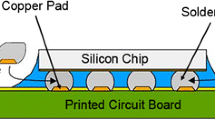Abstract
Owing to concerns regarding the environment and health, lead-containing solders have now been eliminated and substituted by their lead-free counterparts. Hence, the present article is devoted to the clarification of their mechanical strength and reliability. Lead-free Sn-3.5Ag solder joints of various thicknesses were exposed to different thermal treatments in order to study the effect of material changes due to ageing. Thereafter, tensile tests were performed showing a pronounced decrease of strength after excessive heat treatment. The theoretical analysis is facilitated by simulations according to the finite element method. Thereby, the influence of material changes in the solder could be separated from the effect of thermal recovery in the copper base material. Crack initiation in the solder is described by an approach of damage mechanics derived from a thermodynamic framework. Excessive heat treatment leads to Kirkendall voids reducing the ultimate tensile strength of solder joints. Therefrom, one can estimate the reduction of tensile strength as a function of time and temperature.
Graphical abstract







Similar content being viewed by others
References
Pietrikova A, Durisin J (2010) Acta Electrotech Informatica 10:43
Tu PL, Chan YC, Hung KC, Lai JKL (2001) Scripta Mater 44:317
Wei YY, Duh JG (1998) J Mater Sci Mater Electr 9:373
Mahat MM, Sha’ri DNA, Junid R, Razak JA (2011) Can J Mech Sci Eng 2:37
Belyakov S, Atkinson HV, Gill SPA (2010) J Electr Mater 39:1295
Pan J, Chou TC, Bath J, Willie D, Toleno BJ (2009) Solder Surf Mount Tech 21:32
Chavali S, Singh Y, Kumar P, Subbarayan G, Dutta I, Edwards DR (2011) Electronic components and technology conference, pp 701
Chiu TC, Zeng K, Stierman R, Edwards D, Ano K (2004) Electronic components and technology conference, pp 1256
Xiao Q, Nguyen L, Armstrong WD (2004) Electronic components and technology conference, pp 1325
Zimprich P, Saeed U, Betzwar-Kotas A, Weiss B, Ipser H (2007) J Electr Mater 37:102
Shen YL (2008) Prog Mater Sci 53:838
Khatibi G, Ipser H, Lederer M, Weiss B (2012) Influence of miniaturization on mechanical reliability of lead-free solder interconnects. In: Subramanian KN (ed) Lead-free solders. Wiley, New York, p 445
Cugnoni J, Botsis J, Sivasubramaniam V, Janczak-Rusch J (2007) Fatigue Fract Engng Mater Struct 30:387
Ranieri JP, Lauten FS, Avery DH (1995) J Electr Mater 24:1419
Huang Z, Conway PP, Thomson RC (2007) Microelect Reliab 47:1997
Hedge P, Whalley DC, Silberschmidt VV (2009) European microelectronics and packaging conference, EMPC 2009, art. no. 5272887
Pang HLJ, Tan KH, Shi XQ, Wang ZP (2001) Mater Sci Eng A307:42
Yin LM, Zhang XP, Lu C (2009) J Electr Mater 38:2179
Wiese S, Roellig M, Mueller M, Wolter KJ (2008) Microelect Reliab 48:843
Siewert TA, Smith DR, Cheng YW, Madeni JC, Liu S (2005) National Institute of Standards and Technology and the Colorado School of Mines. Proceedings of the welding and joining conference
Lemaitre J (1985) J Eng Mater Techn 107:83
Basaran C, Yan CY (1998) J Electr Packaging 120:379
Ziering A (2012) Diploma thesis, University of Vienna
Chen X, Chen G, Sakane M (2004) Intersociety conference on thermal phenomena, vol 2, pp 447
Bridgman PW (1952) Studies in large plastic flow and fracture. McGraw-Hill, New York
Lewandowski JJ, Lowhaphandu P (1998) Inter Mater Rev 43:145
Rice JR, Tracey DM (1969) J Mech Phys Solids 17:201
Johnson GR, Cook WH (1985) Eng Fract Mech 21:31
Acknowledgments
We like to thank the Austrian Research Promotion Agency (FFG) for financial support through the COMET program.
Author information
Authors and Affiliations
Corresponding author
Additional information
This article is dedicated to the 65th birthday of Prof. Herbert Ipser who contributed formidably to the issue of lead-free soldering.
Rights and permissions
About this article
Cite this article
Lederer, M., Khatibi, G. & Weiss, B. Damage accumulation and fracture in aged lead-free Sn-3.5Ag solder joints. Monatsh Chem 143, 1335–1339 (2012). https://doi.org/10.1007/s00706-012-0758-9
Received:
Accepted:
Published:
Issue Date:
DOI: https://doi.org/10.1007/s00706-012-0758-9



